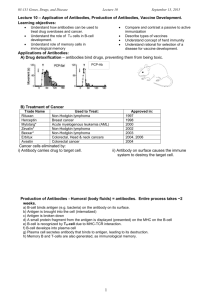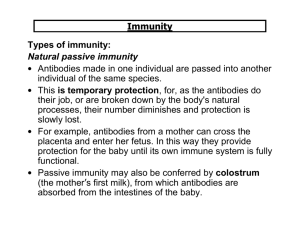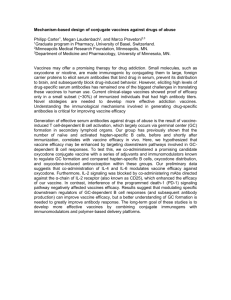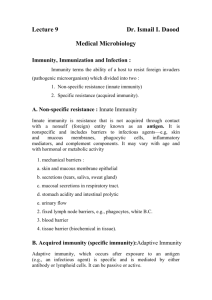Chapter 18 Practical Applications of Immunology
advertisement
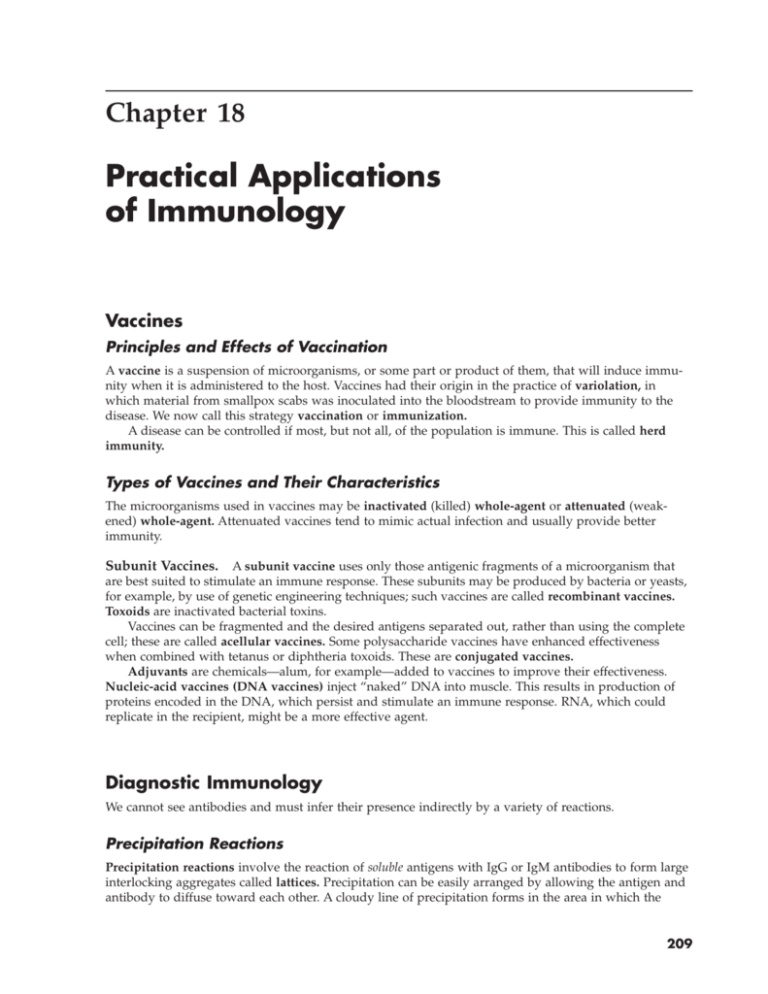
Chapter 18 Practical Applications of Immunology Vaccines Principles and Effects of Vaccination A vaccine is a suspension of microorganisms, or some part or product of them, that will induce immunity when it is administered to the host. Vaccines had their origin in the practice of variolation, in which material from smallpox scabs was inoculated into the bloodstream to provide immunity to the disease. We now call this strategy vaccination or immunization. A disease can be controlled if most, but not all, of the population is immune. This is called herd immunity. Types of Vaccines and Their Characteristics The microorganisms used in vaccines may be inactivated (killed) whole-agent or attenuated (weakened) whole-agent. Attenuated vaccines tend to mimic actual infection and usually provide better immunity. Subunit Vaccines. A subunit vaccine uses only those antigenic fragments of a microorganism that are best suited to stimulate an immune response. These subunits may be produced by bacteria or yeasts, for example, by use of genetic engineering techniques; such vaccines are called recombinant vaccines. Toxoids are inactivated bacterial toxins. Vaccines can be fragmented and the desired antigens separated out, rather than using the complete cell; these are called acellular vaccines. Some polysaccharide vaccines have enhanced effectiveness when combined with tetanus or diphtheria toxoids. These are conjugated vaccines. Adjuvants are chemicals—alum, for example—added to vaccines to improve their effectiveness. Nucleic-acid vaccines (DNA vaccines) inject “naked” DNA into muscle. This results in production of proteins encoded in the DNA, which persist and stimulate an immune response. RNA, which could replicate in the recipient, might be a more effective agent. Diagnostic Immunology We cannot see antibodies and must infer their presence indirectly by a variety of reactions. Precipitation Reactions Precipitation reactions involve the reaction of soluble antigens with IgG or IgM antibodies to form large interlocking aggregates called lattices. Precipitation can be easily arranged by allowing the antigen and antibody to diffuse toward each other. A cloudy line of precipitation forms in the area in which the 209 210 Chapter 18 optimal ratio has been reached (the zone of equivalence). In a capillary tube this is called a precipitin ring test. In a Petri dish the antigens and antibodies can be placed into wells cut into the agar medium, called immunodiffusion tests. If passive diffusion of the reagents is too slow, the test can be speeded up by applying an electric current, a procedure called immunoelectrophoresis, used in research to separate proteins in human serum. Agglutination Reactions Agglutination reactions involve particulate antigens that can be linked together by antibodies in a process called agglutination. Direct Agglutination Tests. Direct agglutination tests detect antibodies against relatively large cellular antigens, such as red blood cells, bacteria, and fungi. The amount of antigen in each well of a microtiter plate is the same. The serum containing the antibodies is sequentially diluted out in a series of wells. The higher the concentration of antibodies in the serum, the more dilutions are required to dilute it to the point at which no reaction occurs with the antigen. This is a measure of titer, or concentration of antibody. For diagnostic purposes a rise in titer during the course of a disease indicates that the antibodies are associated with the disease. If it can be shown that a person’s blood has no antibody titer before illness, but develops one while the disease is progressing, this is called seroconversion, and is diagnostic. Indirect (Passive) Agglutination Tests. Soluble antigens can respond to agglutination tests if the antigens are adsorbed onto particles, especially minute latex spheres. In such indirect, passive, agglutination tests (usually called latex agglutination tests), the antibody reacts with the soluble antigen adhering to the latex particle. This is the basis of many new diagnostic tests. Hemagglutination. Certain viruses have the ability to agglutinate red blood cells, a process called viral hemagglutination. This is not an antibody–antigen reaction. Neutralization Reactions The harmful effects of a bacterial exotoxin or a virus can be neutralized by specific antibodies. One such substance is called an antitoxin, as used in the treatment of diphtheria. Antitoxins produced in other animals can be injected to provide passive immunity against a toxin. Similarly, if an antibody binds to a virus, it prevents it from attaching to a host cell and infecting it. If a person’s serum contains antibodies against viruses that cause hemagglutination, these antibodies will react with the viruses and neutralize them. This is the basis of the viral hemagglutination inhibition test, used in the diagnosis of influenza, measles, and mumps. Practical Applications of Immunology 211 Complement-Fixation Reactions Complement (see Chapter 16) is a group of serum proteins. During most antigen–antibody reactions, the complement binds to the antigen–antibody complex and is fixed. This complement fixation can be used to detect antibody presence. Antibodies that do not produce a visible reaction by other means can sometimes be demonstrated by the fixing of complement during the antigen–antibody reaction (see Figure 18.9 in the text). Fluorescent-Antibody Techniques Fluorescent-antibody (FA) techniques use fluorescent dyes (fluorescein) that are combined with antibodies to make them fluoresce when exposed to ultraviolet light. This requires a fluorescence microscope with ultraviolet light illumination. In a direct FA test, the antigen to be identified is fixed onto a slide. The fluorescein-labeled antibodies are added. The unbound antigen is washed free, and the slide is examined under the ultraviolet microscope. In an indirect FA test, a known antigen is fixed onto a slide. A test serum with an unknown antibody is added. If the serum contains antibodies against the test antigen, it will bind to it, but this is not visible. So that the antigen–antibody complex can be seen, fluorescein-labeled antihuman gamma globulin, an antibody that reacts specifically with any human antibody, is added to the slide. Unbound reagents are washed from the slide, which is examined under the fluorescence microscope. If the known antigen on the slide appears fluorescent, antibody specific to it was in the test serum. A fluorescence-activated cell sorter (see Figure 18.11 in the text) uses FA markers to isolate and identify cells such as T cells. Enzyme-Linked Immunosorbent Assay (ELISA) One of the most widely used serological tests is the enzyme-linked immunosorbent assay (ELISA), the most widely used of a group of tests called enzyme immunoassays (EIA). A microtiter plate with numerous shallow wells is used in the two basic methods we will describe. Variations of the test may use reagents bound to tiny latex particles rather than to the surfaces of the microtiter plates. In the direct ELISA, the goal is to identify an unknown antigen, such as a drug in a serum sample. In the indirect ELISA, the object is to determine the presence of certain antibodies in the serum. This assay currently is used to test for antibodies against the AIDS virus. In both of these variations of the ELISA, a positive reaction is indicated by a color change in the well due to action of an enzyme linked to the last antibody added and allowed to react with a substrate added in the final step. Figure 18.1 shows the mechanism of ELISAs. 212 Chapter 18 Direct ELISA Indirect ELISA 1 Antibody is adsorbed to well. 1 Antigen is adsorbed to well. 2 Patient sample is added; complementary antigen binds to antibody. 2 Patient antiserum is added; complementary antibody binds to antigen. 3 Enzyme-linked antibody specific for test antigen is added and binds to antigen, forming sandwich. 3 Enzyme-linked anti-HISG is added and binds to bound antibody. 4 Enzyme's substrate ( ) is added, and reaction produces a product that causes a visible color change ( ). 4 FIGURE 18.1 Enzyme's substrate ( ) is added, and reaction produces a product that causes a visible color change ( ). The ELISA method. The components are usually contained in small wells of a microtiter plate. Practical Applications of Immunology Self-Tests In the matching section, there is only one answer to each question; however, the lettered options (a, b, c, etc.) may be used more than once or not at all. I. Matching 1. Makes use of the fact that certain viruses will cause agglutination of red blood cells. 2. The absence of complement is indicated by hemolysis. 3. A precipitation-type test in which wells are cut into the agar on a Petri dish. 4. Soluble antigens are detected by binding them to small latex particles, for example, and causing their agglutination. a. Immunodiffusion test b. Indirect agglutination test c. Complement-fixation test d. Direct ELISA e. Indirect ELISA f. Hemagglutination inhibition test 5. The ELISA used to screen for AIDS antibodies in serum. II. Matching 1. Subunit vaccine using genetically engineered organisms to produce it. 2. Unwanted components are removed from a whole-cell vaccine. 3. An inactivated toxin. 4. “Naked” DNA or RNA injected into muscle. 5. Chemical additive that improves effectiveness of a vaccine. a. Recombinant vaccine b. Toxoid c. Acellular vaccine d. Antitoxin e. Nucleic-acid vaccine f. Adjuvant Fill in the Blanks 1. Before the invention of modern vaccines, material from smallpox scabs was inoculated into the bloodstream to give immunity to the disease; this was called . 2. The measure of the concentration of antibody in serum is called . 3. Fluorescein-labeled antihuman gamma globulin would be used in the fluorescent antibody test. 4. A vaccine using a living, weakened organism is called . 213 214 Chapter 18 5. For diagnostic purposes, a rise in during the course of a disease is very significant. 6. A disease can be controlled if most, but not all, of the population is immune; this is called immunity. 7. Polysaccharide vaccines can be enhanced in effectiveness by adding toxoids such as diphtheria; these are so-called vaccines. Label the Art a. b. Precipitate formed Antibody in precipitate c. Zone of d. Zone of e. Zone of Antigen added Critical Thinking 1. Discuss herd immunity as it relates to the control of disease. 2. Compare and contrast attenuated and inactivated vaccines. Which type of vaccination usually provides better immunity? Why? Practical Applications of Immunology 215 3. Discuss two advantages of recombinant vaccines. Are there any disadvantages? 4. Why is the vaccinia virus a good choice for making subunit vaccines using recombinant methods? 5. How is the measured antibody titer used to diagnose disease? Which of the following titers indicates greater immunity, 1:94 or 1:312? Why? Answers Matching I. 1. f 2. c 3. a 4. b 5. e II. 1. a 2. c 3. b 4. e 5. f Fill in the Blanks 1. variolation 2. titer 3. indirect 4. attenuated 5. titer 6. herd 7. conjugate Label the Art a. antigen b. antibody c. antibody excess d. equivalence e. antigen excess Critical Thinking 1. Herd immunity refers to a situation in which most individuals of a population are immune to a disease. If an outbreak of the disease occurs, there will not be enough susceptible individuals to support an epidemic. 2. Attenuated and inactivated vaccines are both examples of whole-agent vaccines. The process for making the vaccines and the results achieved by using the vaccines differ. Attenuated vaccines use weakened microorganisms to confer immunity to the recipient. Very often viruses used for this type of vaccine are derived from viruses that have mutated during long-term cell culture. Many attenuated vaccines provide lifelong immunity and may be 95% effective. This is due to the fact that the attenuated virus replicates in the body, increasing the original dose. Inactivated vaccines use killed viruses. The viruses are killed by treatment with formalin or other chemicals. Even though the viruses are dead, they still stimulate an immune response. Inactivated vaccines are usually used in situations in which live vaccines are considered too risky. 216 Chapter 18 3. Recombinant vaccines, or subunit vaccines, are produced by genetically altered organisms such as a yeast. The genetically engineered yeast produces a portion of the virus, such as a viral coat protein. Subunit vaccines are safer than whole-agent vaccines because they cannot cause infection in the recipient under any circumstances. 4. The vaccinia virus is a good choice for the production of subunit vaccines because it is harmless and has a relatively large genome. This means that there is room to insert several genes so that the vaccinia virus might be used as a vaccine for several diseases simultaneously. 5. Titer refers to the concentration of serum antibody and is the lowest dilution of the antibody that will result in agglutination. In general, the higher the serum antibody titer, the greater the immunity to the disease. This means that a titer of 1:312 shows greater immunity to a disease than a titer of 1:94.

